
Return to Gallery
Display Contents
Flint and stone axes from Thanet
A little explanation
Curator's introduction
Flint axes
Polished flint axes
Polished non-flint axes
Flint axe fragments
Polished flint axe fragments
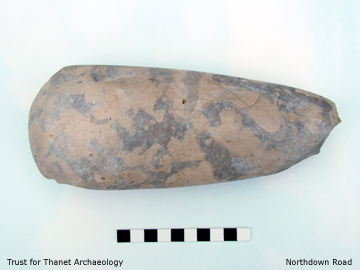
Victoria Avenue Westgate
Major Powell-Cotton
Thanet axes - a review
Artefact scales in centimetre divisions
Flint and stone? In this sense, the term 'stone axe' is used to refer specifically to non-flint axes.
These
are made of a much coarser-grained rock, which are either
crudely flaked or 'pecked' into the basic tool shape - known as a
pre-form or 'roughout'. The surface is then ground smooth and sometimes
finished by further polishing.
Polished
axes are one of the classic stone tools of the
Neolithic. The technique of polishing stone first appears in Britain Ireland
These axes are often
finished far above their functional
need and seem to represent something more than just a wood-working
tool. For their owners and contemporaries they could have made
statements about status and cultural affinities. The circumstances of their disposal also shows how
these objects were viewed and valued at that time.
Current knowledge details
eleven
polished flint axes and one un-polished flint axe certain to
have originated in Thanet. There are also fragments from five polished
flint axes, at least one
and possibly two polished
non-flint axes and possibly one un-polished flint axe.
No
complete non-flint axes are known to have been found in Thanet.
(I) Northdown, pre 1934.
Only one un-polished flint
axe is known from Thanet. It was discovered at Northdown
prior to 1934 and comes from the collection of a P.T. Harris. It may
now reside at Folkestone museum The existence of this piece was
originally uncovered through work by Rita Mortenson, but has only
recently been rediscovered. Investigation underway!
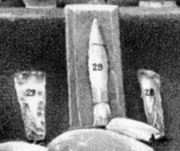
Two polished flint axes
and a large flint knife
from West Cliff, Ramsgate
Copyright R.Hicks
(I) West Cliff, Ramsgate pre 1877.
Two polished flint axes have
been recovered from here.
(i)
A 'polished stone celt' was found, along with another example (see
below) and a
'beautiful flint knife'.
They are described as being 'discovered together on the West Cliff'.
(ii) A 'polished stone celt' was
discovered here along with another example (see above) and a 'beautiful
flint knife'. They are described as being 'discovered together on the
West Cliff'.
Hicks 1877.
Hicks 1877.
A polished flint axe
was found during excavations in the grounds of Stone House
School (these lasted from 1905 to 1971). In style it is somewhat
similar
to the examples found at the West Cliff, Ramsgate (I above). A flint
'floor' containing Neolithic scrapers
was also uncovered. The collection is now held at the Monkton
Nature
Reserve.
NGR TR 3960 6910.
TSMR 872.
NGR TR 3960 6910.
TSMR 872.
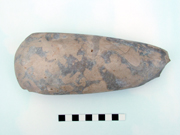
In January 1940 a very
large, completely
polished grey-flint axe was found by Mr. F.J. Kelf while digging an air-raid
shelter behind
his shop at 101 Northdown Road. It was discovered at last 4 feet below
ground level. The flint derives from
either Lincolnshire or Belgium (Jessop 1970). The axe is impractical,
unused and likely to have had a symbolic or ritual function. Possibly
Late Neolithic/Early Bronze Age.
NGR TR 3627 7098.
TSMR 356.
Biggs 1972; Jessop 1970; Minter and Herbert 1973.
NGR TR 3627 7098.
TSMR 356.
Biggs 1972; Jessop 1970; Minter and Herbert 1973.
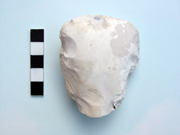
Excavation led by David
Perkins and Nigel Macpherson Grant, Thanet Archaeological Unit; (LOM77
IIIA).
A flint axe with one surface completely polished and the other surface flaked was recovered from monument III at Lord of the Manor. Other details unknown at present.
A flint axe with one surface completely polished and the other surface flaked was recovered from monument III at Lord of the Manor. Other details unknown at present.
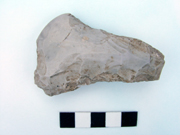
An edge-polished flint axe
of uncommon grey-coloured flint was recovered from the ploughsoil
along the footpath. The cutting edge appears
splayed and may be
imitating the form of early metal axes. However this may just be a
result of reworking.
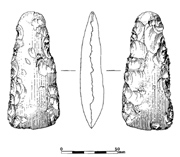
Copyright Wessex Archaeology
(VI) Ebbsfleet
1994.
Excavation by Wessex Archaeology and the Trust for Thanet Archaeology led by David Perkins.
A partly polished/ground flint axe was found redeposited in a ring-ditch at the Southern Water works at Ebbsfleet, near Weatherlees Hill. The feature was nearly perfectly circular, about 4m in diameter with the ditch about 0.25m wide. A small slot was excavated which revealed a V-sectioned ditch 0.20m deep containing the polished axe.
The axe appeared to have been laid down along the base of the gully. The top fill of the ditch contained a small sherd of probable Late Bronze Age/Early Iron Age pottery.
Hearne, Perkins and Andrew 1995.
A partly polished/ground flint axe was found redeposited in a ring-ditch at the Southern Water works at Ebbsfleet, near Weatherlees Hill. The feature was nearly perfectly circular, about 4m in diameter with the ditch about 0.25m wide. A small slot was excavated which revealed a V-sectioned ditch 0.20m deep containing the polished axe.
The axe appeared to have been laid down along the base of the gully. The top fill of the ditch contained a small sherd of probable Late Bronze Age/Early Iron Age pottery.
Hearne, Perkins and Andrew 1995.
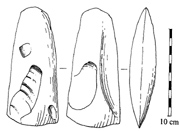
Illustration by David Perkins
Trust for Thanet Archaeology
A
completely polished flint
axe was recovered from the ploughsoil at Netherhale Farm by a farm
worker. It has a white-pale blue patination and exhibits minor recent
(plough?) damage.
NGR TR 2785 6795.
Perkins 1997
NGR TR 2785 6795.
Perkins 1997
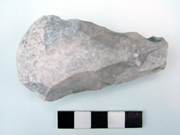
Excavation led by Paul Hart, Trust for
Thanet Archaeology; (BNF04).
A reworked polished flint axe was discovered redeposited in the ditch of a Beaker Barrow at Beauforts, North Foreland Avenue, Broadstairs. The fill of the central burial also contained residual Early Neolithic flintwork.
Hart 2005.
A reworked polished flint axe was discovered redeposited in the ditch of a Beaker Barrow at Beauforts, North Foreland Avenue, Broadstairs. The fill of the central burial also contained residual Early Neolithic flintwork.
Hart 2005.
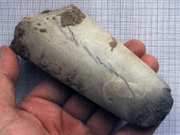
Copyright Canterbury Archaeological Trust
Excavation led by Adrian Gollop,
Canterbury Archaeological Trust.
A part-broken polished axe was found during an excavation at the site of the new service station near the A253 Minster roundabout. The axe appears to be a grey colour and could be non-local.
It is described only as a 'polished axe' and may not be made of flint, though it appears to be so. Context unknown; other details unknown at present.
KAS 2005.
A part-broken polished axe was found during an excavation at the site of the new service station near the A253 Minster roundabout. The axe appears to be a grey colour and could be non-local.
It is described only as a 'polished axe' and may not be made of flint, though it appears to be so. Context unknown; other details unknown at present.
KAS 2005.
Polished non-flint
axes
At the moment there are no complete non-flint axes known to have been found on Thanet.
At the moment there are no complete non-flint axes known to have been found on Thanet.
The excavations along the
Monkton-Minster A253 and at the Earlier Neolithic Causewayed Enclosure
at Chalk Hill, Chilton (both by Canterbury Archaeological Trust) have
produced the only evidence for the use of non-flint axes on the Isle.
In both cases only fragments of these stone axes have been recovered
(see further below).
(I) Westwood Road, Broadstairs, 2004.
Evaluation led by Christopher Currie,
CKC Archaeology, assisted by the Trust for Thanet Archaeology.
An evaluation at 33 Westwood Road uncovered 'what appeared to be a broken butt-end of a hand axe, possibly of Neolithic date. The axe may have been a rejected tool, as it was later used as a hammer stone'.
An evaluation at 33 Westwood Road uncovered 'what appeared to be a broken butt-end of a hand axe, possibly of Neolithic date. The axe may have been a rejected tool, as it was later used as a hammer stone'.
It is presumed that this axe was of
flint and was indeed a Neolithic axe rather than a 'handaxe' and of
Lower Palaeolithic date (several of these have been found close-by,
including one at a site immediately adjacent to this one - see the
Palaeolithic Gallery for more information).
NGR TR 3777 6804.
TSMR 827.
Currie 2004.
(I) Minnis Bay Birchington 1968 (?).
Parts of two polished axes were found
amongst other worked
flints (including a leaf-shaped arrowhead) on an ancient landsurface at
this inundated site. They came from the west bank of what was either a
stream or possibly a tidal inlet. The finds are held at Quex Park.
Macpherson Grant 1969.
Excavation led by Nigel Macpherson
Grant, Thanet Archaeological Unit; (LOM76).
A fragment of a polished axe
(presumably of flint) was recovered
from the large outer ditch of the triple ring-ditched Lord of the Manor
I. This outer ditch was constructed during the first phase
of activity
at this site, probably in the Late Neolithic period. The ditch was
subsequently recut in the Beaker Period; two further ditches were
later dug in separate phases during the Early Bronze Age.
Macpherson Grant 1977.
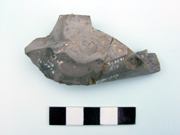
Evaluation led by David Perkins, Trust
for Thanet Archaeology; (SCFE91).
Three conjoining burnt fragments of a polished flint axe was found during excavations on this site. Other details unknown at present.
Three conjoining burnt fragments of a polished flint axe was found during excavations on this site. Other details unknown at present.
Excavation led by Jack Russell, Trust
for Thanet Archaeology; (MRR04).
One small flake which may have originated from a larger polished tool (possibly an axe) was discovered during excavations next to the Tesco store. Its surface appears dull (with fine striations) and is not highly polished.
One small flake which may have originated from a larger polished tool (possibly an axe) was discovered during excavations next to the Tesco store. Its surface appears dull (with fine striations) and is not highly polished.
This piece of grey-coloured flint is
very similar in character to that
of the St. Peters footpath axe.
Boast, Gardner and Moody 2006.
Boast, Gardner and Moody 2006.
(I) Monkton-Minster A253 1993.
Excavation by Canterbury Archaeological Trust and
the Trust for Thanet
Archaeology led by David
Perkins.
Excavations in Area 9 revealed a post-hole (no.287), which contained fragments of a 'polished stone axe'.
Fisk 2003; Rady and Clark forthcoming.
This term is slightly ambiguous and in other sources has been used in reference to axes known to be made of flint. Canterbury Archaeological Trust's final report on this important excavation is keenly anticipated.
Excavations in Area 9 revealed a post-hole (no.287), which contained fragments of a 'polished stone axe'.
Fisk 2003; Rady and Clark forthcoming.
This term is slightly ambiguous and in other sources has been used in reference to axes known to be made of flint. Canterbury Archaeological Trust's final report on this important excavation is keenly anticipated.
Excavated by Canterbury Archaeological
Trust.
This site, which featured an Earlier Neolithic Causewayed Enclosure, produced a flake from a Group VI axe. Context unknown; other details unknown. Likewise the final report on this site is eagerly awaited.
Shand 2002.
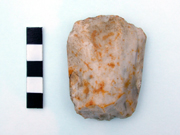
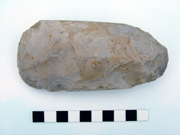
Victoria Avenue, Westgate
During work in the back garden of No.14 the owner discovered several hundred worked flints, of which he retained a few of the more interesting ones. Among them were two polished flint axes, an arrowhead and scrapers etc. All were found in an area only 10m across.
During work in the back garden of No.14 the owner discovered several hundred worked flints, of which he retained a few of the more interesting ones. Among them were two polished flint axes, an arrowhead and scrapers etc. All were found in an area only 10m across.
These flints could represent a
discarded modern collection, though
the owner believes he extracted them from an ancient horizon.
It should be remembered that the garden adjoins Street Court, where Prehistoric and Roman finds are believed to have been made.
TR 3280 6980.
TSMR 307.
The two axes found at this site have not been included in the list of Thanet axes outlined above because their true nature and source is uncertain. Other tools which are part of this collection are made of flint and chert which is certainly not local.
It should be remembered that the garden adjoins Street Court, where Prehistoric and Roman finds are believed to have been made.
TR 3280 6980.
TSMR 307.
The two axes found at this site have not been included in the list of Thanet axes outlined above because their true nature and source is uncertain. Other tools which are part of this collection are made of flint and chert which is certainly not local.
There is a reference to the discovery of an axehead and a flint arrowhead during the excavation of a possible pit dwelling by Major Powell-Cotton in 1924 (Grove 1950). However Quex Park know of no excavation at the grid reference given (TR 2942 6715). It may be a mis-reference to the excavation of a pit at Monkton Farm (TR 2921 6699). These finds are held by the museum and contain no axe or arrowhead.
TSMR 430.
Grove 1950.
If you would like to read a short
discussion of the flint and stone axes found on Thanet, including some
larger
versions of the pictures seen above, please click here.
Arch Cant - Archaeologia Cantiana: journal of the Kent Archaeological Society.
BAR - British Archaeological Reports.
BSPAS - Broadstairs and St. Peters Archaeological Society.
CBA - Council for British Archaeology.
KAS - Kent Archaeological Society.
TSMR - the Thanet Sites and Monuments Record.
Biggs H. 1972. Kent Archaeological Review.
Boast E.J., Gardner O.W. and Moody G.A. 2006. East Kent Community NHS Health Trust Medical Centre, Manston Road, Ramsgate, Kent. Trust for Thanet Archaeology Report.
Bradley R. 1984. (Precise publication uncertain).
Currie C.K. 2004. An archaeological evaluation at 33 Westwood Road, Broadstairs, Kent.
Fisk P. M. 2003. An examination of the excavated ring ditch enclosures on the Isle of Thanet. Unpublished Degree thesis.
Grove L.R.A. 1950 (precise reference uncertain at present).
Hart P.C. 2005. Beauforts, North Foreland Avenue, Broadstairs, Kent. Trust for Thanet Archaeology report.
Hicks R. 1877. Roman remains found at Ramsgate. Archaeologia Cantiana XII.
Jessop 1970 (the precise publication details of his book on the archaeology of the South-East is uncertain at present).
Hearne C.M., Perkins D.R.J. and Andrews P. 1995. The Sandwich Bay wastewater treatment scheme Archaeological Project, 1992-1994. Archaeologia Cantiana CXV.
KAS 2005. Kent Archaeological Society summer newsletter 65.
Lewis M. and Parfitt K. 2002. A Neolithic stone axe: Offham, near West Malling. Archaeologia Cantiana CXXII.
Macpherson Grant N. 1969. Two Neolithic bowls from Birchington, Thanet. Archaeologia Cantiana LXXXIV.
Macpherson Grant N. 1977. Excavation of a Neolithic/Bronze Age Site at Lord of the Manor, Haine Road, Ramsgate. Isle of Thanet Archaeological Unit, Publication No. 1.
Minter K.S. and Herbert E.F. 1973. Archaeological discoveries in Broadstairs and St. Peter’s up to 1972. Broadstairs and St. Peter’s Archaeological Society.
Perkins D.R.J. 1997. A polished flint axe from Netherhale, Thanet. Archaeologia Cantiana CXVII.
Shand G. 2002. Excavation at Chalk Hill, near Ramsgate 1997-98. Canterbury Archaeological Trust, Integrated assessment and updated research design report.
Smith I.F. 1979. The chronology of British stone implements, in McClough T.H. and Cummins W.A. Stone axe studies. CBA research report 23.
Thorpe I.J. and Richards C. 1984. The decline of ritual authority and the introduction of Beakers into Britain, in Bradley R. and Gardiner J. Neolithic studies. A review of some current research. BAR British Series 133.
Thanks go to Ges Moody
for the reproduction and enhancement of the Hicks picture from
Archaeologia
Cantiana.
Version 1 - Posted 27.07.06
Version 2 - Posted 10.08.06
Version 3 - Posted 26.09.06
Version 4 - Posted 16.12.06
All
content © Trust for Thanet Archaeology